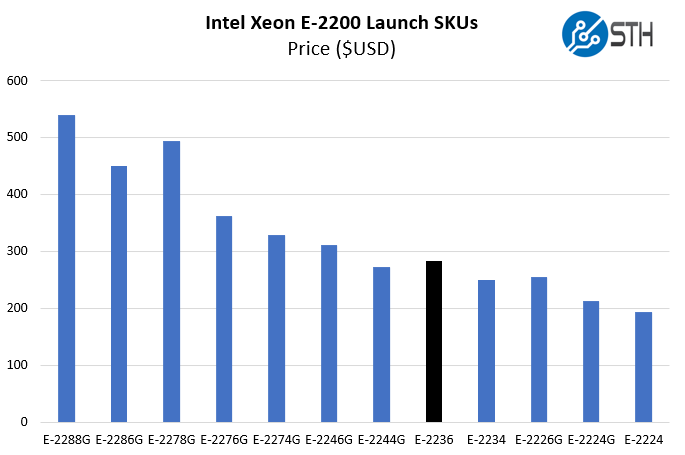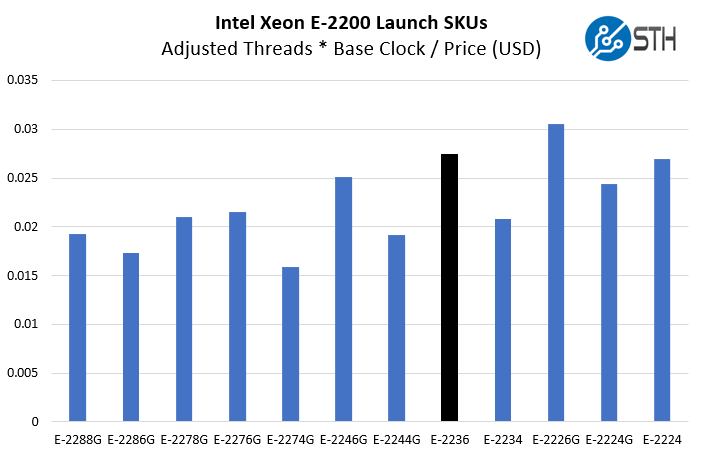Intel Xeon E-2236 Power Consumption
We wanted to post a few figures from our testing that show the real selling point of the chips, low power.
-
- Idle Power (Performance Mode): 31W
- STH 70% Load: 80W
- STH 100% Load: 102W
- Maximum Observed Power (Performance Mode): 110W
Note these results were taken using a 208V Schneider Electric / APC PDU at 17.7C and 72% RH. Our testing window shown here had a +/- 0.3C and +/- 2% RH variance. This is a fairly good performance.
Intel Xeon E-2236 Market Positioning
The Intel Xeon E-2236 is not being released in a vacuum. Instead, there are other parts available in the socket which means that our readers need to decide on a chip in the context of a configurator. Here is what the parts look like ordered by part number:

We wanted to call attention to the Intel Xeon E-2234. This is where pricing gets a little strange in the Xeon E-2200 line. For only $34 more or 13.6% more, one gets 50% more cores with a very small 9W TDP and 200MHz base clock speed penalty. That is a deal that we would tell any of our readers to take. In the context of a server, whether that is a $750 low-end edge box or a $6000-7000 NAS like the QNAP GM-1002 (without drives) we that $34 is relatively small for a relatively large performance bump.
When we take into account threads, clock speed, and price, this is what the above chart looks like:

While our benchmarks showed that there is a lot of merit for simply moving from 4-cores to 6-cores in this segment, there are other questions to be answered. Perhaps the big one is what happens up the stack. Based on the above, getting a Xeon E-2236 over an E-2246G may seem like a sensible option. One has to remember that not only do we get slightly more performance from the Xeon E-2246G but also get an iGPU. If you want an iGPU even if for features such as Quick Sync video transcoding, $27 seems like a tremendous value.
Looking at the Xeon E-2226G we get another 6-core part at a $29 lower cost and with an iGPU. The big feature we lose with that part is Hyper-Threading.
Of course, for those thinking about these chips in workstations, the Xeon W-1200 series is now out that offers more performance, but those are primarily for the workstation market with parts such as the Xeon W-1270 and Xeon W-1290P.
[Editor’s note] Perhaps the overall takeaway here is at a higher-level. On the Xeon Scalable side and the AMD EPYC 7000 series we often have large swings of price and core counts. Although sometimes these SKU stacks feel complex, scaling from 4-8 cores up to 28-64 cores means there is a lot of room to move. The Xeon E-2200 series, especially in the middle of the stack seems like extreme micro-segmentation as we see on the desktop side. This makes sense given these are largely desktop-derived parts. Having a broader industry view makes one wonder if these should mostly be 4, 6, and 8 core parts, with and without iGPUs for a 6-SKU stack. At STH, we like more SKUs because it gives us something to benchmark and discuss. Tor the market, however, we wonder whether 200MHz increments make sense to keep as segmentation as core counts increase.
Final Words
The Intel Xeon E-2236 is a solid CPU, assuming you do not need an iGPU. If we take the six basic configurations of the Xeon E-2200 series based on the number of cores (assuming Hyper-Threading is enabled) and an optional iGPU we get six configurations. This CPU firmly falls in the 6-core and no iGPU configuration.
Moving up in and down the stack, our sense is the Xeon E-2226, Xeon E-2246G and the Xeon E-2288G are the most interesting. The E-2226G for the lower cost plus iGPU but with only 6 threads is going to appeal to many. The Xeon E-2246G with an iGPU and more clock speed for a bit more is going to be appealing if you need or may need the iGPU. Finally, the Xeon E-2288G just because it is the biggest part in the socket. What the E-2236 does offer is a compelling reason to abandon 4-core CPUs in favor of 6-core models.
With all of this said, if you saw our ASRock Rack X570D4I-2T or ASRock Rack X570D4U-2L2T review, for servers, AMD has a ready-made competitor that can be made into a strong competitor. Intel simply has more focus in this market. For now, that is where we are at. If AMD does enter this market, the Xeon E-2236 will seem outdated quickly.
Overall, we think the Xeon E-2236 is a great part if you will never use iGPU functionality. It is relatively lower-cost and power efficient. If you do ever think there will be a use for an iGPU, we think moving down the E-2226G or up to the E-2246G makes more sense.




It’s a desktop part. ECC I suppose. When is Intel going to start branding Atoms as Xeons?